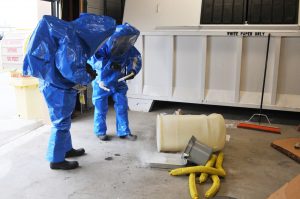If there is a risk for pollution incidents at your facility or site, it is essential to have an effective spill response management plan in place. This response management plan should be prepared in accordance with current EPA regulations and implemented by trained staff members, to both minimise the risk of a spill, and to avoid possible fines or prosecution in the future.
The purpose of a pollution incident response management plan is to improve the management of spills and facilitate better coordination with relevant response groups. To that end, your plan needs to be available on the premises in written form, and should be able to be provided to an EPA officer upon request.
A pollution incident response management plan must cover the following points:
- Description and likelihood of hazards
In your plan, describe the hazards to human health or the environment associated with the activities taking place at the facility or site. This should include an outline of the likelihood of a hazard occurring, and the details of circumstances or events which could increase the likelihood of a pollution incident. Hazards could refer to the storage of chemicals, waste materials, wastewater, the potential failure of containment tanks or pipes, or the flooding of effluent storage dams.
- Pre-emptive actions to be taken
You should also outline the pre-emptive actions currently being taken to minimise or prevent the risk to the environment or human health at your facility. The provision, maintenance, and training of staff in the use of spill kits and other spill response equipment is an example of a pre-emptive action.
- Inventory of pollutants
A spill response management plan must include an inventory of the potential pollutants kept on premises, including the maximum quantity of the pollutant likely to be stored at your facility. Pollutants can include, but are not limited to, chemicals, fuels, lubricants, gas cylinders, waste materials, effluents, and stormwater.
- List of safety equipment
The plan should also include a list of spill response safety equipment kept on premises in the case of a pollution incident. Note the exact location where the safety equipment is stored in the facility, along with any site or activity-specific safety equipment. This list can encompass items such as personal protective equipment, spill containment equipment, gas monitoring meters, and floating booms for spills on waterways.
- Contact details
The names, job titles, and contact details of any key individuals responsible for activating the plan or managing the response should be recorded in your pollution incident response management plan. You should also record the details of those individuals authorised to contact relevant authorities such as the EPA, as well as the contact details of the relevant response groups that will need to be advised of the spill.

- Plan for communicating with the local community
Another point to include in your response plan are details of how neighbours and the local community will be notified in the case of a pollution incident. Note the communication mechanisms which will be used (eg: social media, website announcement, phone calls, emails) to warn and update those affected, as well as any instructions about minimising harmful effects.
- Plan for minimising harm to people on the premises
Your plan should also outline any actions in place to minimise the risk of harm to on-site workers and visitors. This could include evacuation procedures, alarms, and muster locations.
- Location maps
Ensure that your spill response management plan contains detailed maps of your facility. These maps should indicate the surrounding area likely to be affected by a pollution incident, the location of possible hazards and pollutants, the location of any on-site stormwater drains, and the discharge locations of these stormwater drains to the nearest waterway.
- Actions to be taken during or immediately after a pollution incident
Another important point to be included in your response plan is the list of actions to be taken during or immediately following a pollution incident. These actions could include the deployment of spill response equipment, shutdown of machinery, and activation of stormwater shut-off valves, as well as how the clean up will be organised and funded.
- Staff training
Finally, your spill response management plan must include details of any staff training programs, including the frequency of these programs and any record keeping related to the training. Suitable training programs for spill response include formal staff training on incident management, toolbox talks, and simulated incident exercises.
Please note that your spill response management plan should be routinely tested at least every 12 months to ensure that the information included is accurate and up to date, and that the plan can be effectively implemented. To learn more, read our post on preparing your facility for effective spill response in 2019.
SpillShop stocks a variety of quality spill response and liquid containment products which will help clean up spills and help you stay in compliance with current EPA regulations, including spill kits, absorbents, granules, bunding, and drain protection. For more information, visit our FAQ page or Contact Us directly to discuss your needs.


